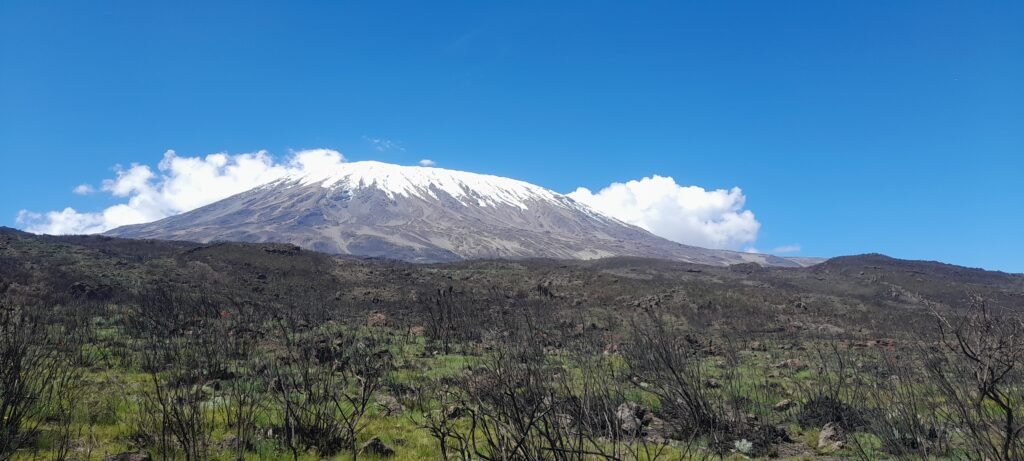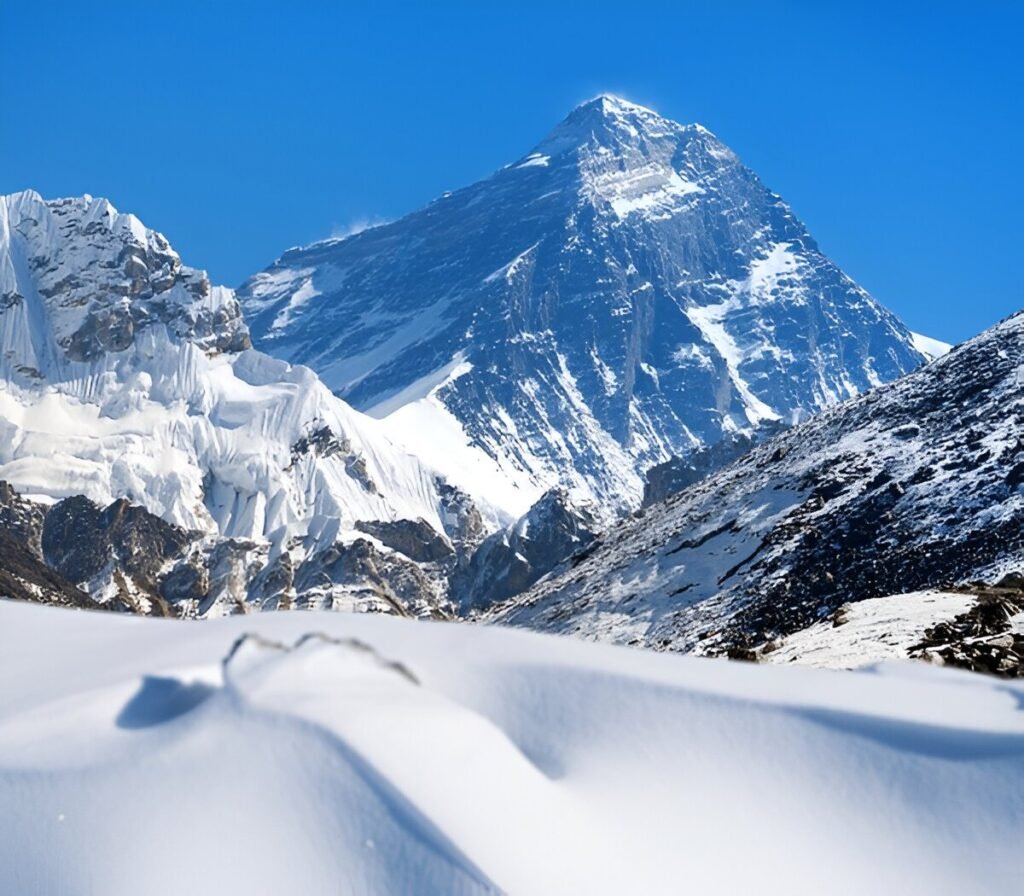Mount Everest Base Camp vs Mount Kilimanjaro : Choosing between trekking to Mount Everest Base Camp and climbing Mount Kilimanjaro is a tough decision for adventurers. Both offer breathtaking views, unique cultural experiences, and personal challenges. However, each trek is distinct in terms of difficulty, altitude, and overall experience. In this guide, we compare Mount Everest Base Camp (EBC) and Mount Kilimanjaro, helping you decide which trek is best for your next adventure.
Plan your perfect Kilimanjaro trek with expert guidance.

Mount Everest Base Camp vs Mount Kilimanjaro: Trekking Routes: Kilimanjaro vs. Everest Base Camp
The routes to Everest Base Camp and Kilimanjaro differ greatly in terms of terrain, scenery, and logistics. Here’s a breakdown of what you can expect from each:
Mount Kilimanjaro
Mount Kilimanjaro, located in Tanzania, has several popular routes, including Marangu, Machame, and Lemosho. The routes take between 5 to 9 days depending on your choice, with landscapes ranging from lush rainforests to arctic-like summit zones. Unlike Everest Base Camp, Kilimanjaro is a standalone peak, and trekkers reach the actual summit, Uhuru Peak, at 5,895 meters (19,341 feet).
- Popular Routes: Marangu (6 days), Machame (7 days), Lemosho (8 days).
- Terrain: Rainforest, moorland, alpine desert, glacier.
Discover the best Kilimanjaro routes for your climb.
Everest Base Camp
The trek to Everest Base Camp in Nepal is approximately 12-14 days long and follows a well-established route through the Khumbu Valley. The trail winds through picturesque Sherpa villages, Buddhist monasteries, and deep valleys with views of some of the world’s highest peaks, including Mount Everest. However, the trek only takes you to Base Camp at 5,364 meters (17,598 feet), not the summit of Everest.
- Route Length: 12-14 days round trip.
- Terrain: Forests, alpine meadows, high-altitude valleys, glaciers.
Learn more about the Everest Base Camp trek route.
Mount Everest Base Camp vs Mount Kilimanjaro : Difficulty and Altitude
Both treks present altitude challenges, but there are key differences in difficulty between Kilimanjaro and Everest Base Camp.
Kilimanjaro Altitude
At 5,895 meters, Kilimanjaro is taller than Everest Base Camp. Climbers experience altitude-related challenges, particularly on summit night when oxygen levels are low. Although the trek itself doesn’t require technical climbing, altitude sickness is a concern, and proper acclimatization is key to reaching the summit.
- Summit Height: 5,895 meters (19,341 feet).
- Acclimatization: Shorter acclimatization compared to Everest, leading to a steeper climb.
Find out how to prepare for Kilimanjaro’s altitude.
Everest Base Camp Altitude
While Everest Base Camp is at a lower altitude than Kilimanjaro’s summit, the trek takes longer, giving trekkers more time to acclimatize. This makes altitude sickness less severe, though it’s still a challenge for some. The gradual ascent allows for a more relaxed pace, but the extended duration can be tiring.
- Base Camp Height: 5,364 meters (17,598 feet).
- Acclimatization: Gradual acclimatization over 10 days with more time to adjust to the altitude.
Learn how to manage altitude on the Everest Base Camp trek.
Mount Everest Base Camp vs Mount Kilimanjaro : Scenery and Landscape
Both treks offer stunning views, but the landscapes are quite different.
Kilimanjaro Scenery
Kilimanjaro takes trekkers through five distinct ecological zones, from lush rainforests to barren, windswept high-altitude deserts. The final ascent to Uhuru Peak offers spectacular views of glaciers, volcanic craters, and the African plains stretching into the distance.
- Highlight: The view from Uhuru Peak, the “Roof of Africa,” is unmatched.
- Diverse Zones: You pass through tropical forests, alpine deserts, and glaciers.
Read more about Kilimanjaro’s unique landscapes.
Everest Base Camp Scenery
The Everest Base Camp trek offers close-up views of some of the tallest mountains on Earth, including Ama Dablam, Lhotse, and of course, Mount Everest. Along the way, trekkers pass through traditional Sherpa villages and Buddhist monasteries, with prayer flags fluttering in the wind. The landscape is dominated by steep valleys, glacial rivers, and alpine forests.
- Highlight: The view of Mount Everest from Base Camp or Kala Patthar.
- Cultural Aspect: The cultural experience with Sherpa villages and monasteries is a big part of the trek.
Discover more about the Everest Base Camp scenery.
Mount Everest Base Camp vs Mount Kilimanjaro : Cultural Experience
The cultural aspects of Kilimanjaro and Everest Base Camp also differ, adding unique dimensions to each trek.
Kilimanjaro Culture
On Kilimanjaro, climbers interact with the local Chagga people, who live around the mountain. Guides and porters share stories about local traditions, and many Kilimanjaro routes pass through Maasai land, giving trekkers a glimpse into one of Tanzania’s most iconic cultures.
- Cultural Interactions: Primarily with Chagga and Maasai people.
- Cultural Insights: Learn about the local tribes and their way of life.
Learn more about the local culture on Kilimanjaro.
Everest Base Camp Culture
The Everest Base Camp trek is deeply rooted in the Sherpa culture of the Khumbu Valley. Trekkers visit Buddhist monasteries, encounter prayer wheels, and see prayer flags decorating the trails. The Sherpas, known for their mountaineering skills, have fascinating traditions and stories to share, making the cultural experience on this trek unforgettable.
- Cultural Interactions: Sherpa people and Tibetan Buddhist traditions.
- Cultural Insights: Experience life in remote Himalayan villages and monasteries.
Explore the rich Sherpa culture of the Everest region.
Mount Everest Base Camp vs Mount Kilimanjaro : Trekking Costs and Logistics
Costs and logistics can be a deciding factor between the two treks.
Mount Kilimanjaro Costs
Kilimanjaro treks tend to be more expensive due to national park fees, guides, and porters. Most climbers opt for a guided trek, and the costs cover permits, food, transportation, and accommodation.
- Average Cost: $1,500 to $4,000, depending on the route and services.
- Accommodation: Camping on the mountain or basic huts on the Marangu route.
Get detailed pricing information for Kilimanjaro treks.
Everest Base Camp Costs
Everest Base Camp treks are often more affordable than Kilimanjaro, with lower permit fees. However, costs can increase if you hire porters, guides, or opt for more luxurious accommodations in teahouses. Flights to Lukla, the starting point, are also a significant expense.
- Average Cost: $1,000 to $3,000, depending on services and guides.
- Accommodation: Teahouses offering basic rooms with shared facilities.
Find out the total cost for Everest Base Camp treks.

Mount Everest Base Camp vs Mount Kilimanjaro :Conclusion
Both Mount Kilimanjaro and Everest Base Camp offer unique experiences for trekkers. If you’re seeking a shorter trek with the goal of summiting Africa’s highest peak, Kilimanjaro might be the adventure for you. However, if you’re more interested in a longer trek with cultural immersion and views of the world’s highest mountains, Everest Base Camp could be your ideal choice.
For customized trekking packages and expert guidance, visit Kilimanjaro Climb Specialist or Eddy Tours & Safaris.

